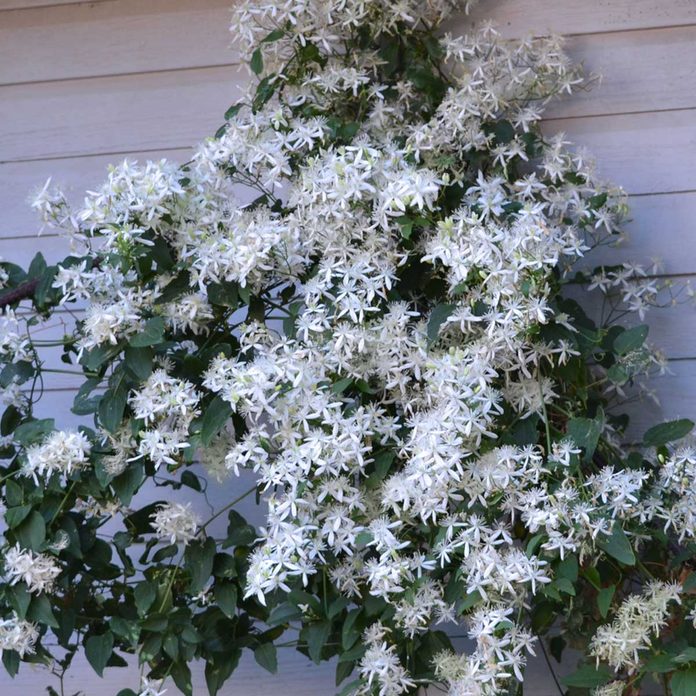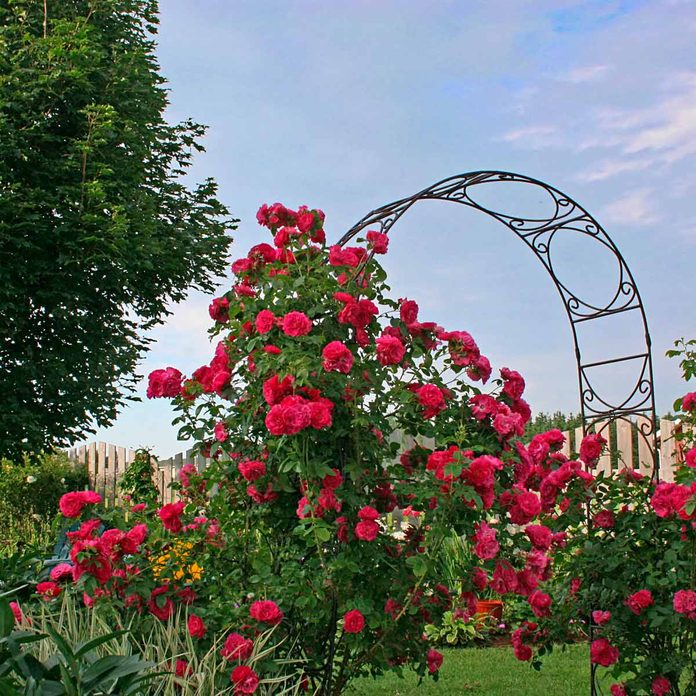Dress up fences, trellises and pergolas with eye-popping flowers from our favorite vines.
10 Great Climbing Plants

Decorate with Flowering Vines
If you want to soften the lines of a railing or fence, a lamp pole or mailbox, or add a decorative trellis in a garden or on a patio, take a look at climbing flowers. They provide a pop of color, lush foliage and even edible privacy screens!

Black-Eyed Susan Vine
Named for its bright yellow five-petaled flowers with dark centers, this annual climber is also known as thunbergia or clockvine. These climbing plants can grow up to five feet in full sun in USDA Plant Hardiness Zones 3 to 9. In Zones 10 and 11, it can be a perennial and add a splash of sunny color to a trellis or lattice screen.

Clematis
This perennial comes in more than 100 varieties for wide-ranging color and petal sizes. It’s easy to grow and can handle most winters. Try “Kilian Donahue” with fuchsia-striped pink petals, “Barbara Harrington” for a pop of vivid red or “Jackmanii” for deep purple blooms. Most like at least five hours of sun each day, but some varieties can thrive in shade. Keep the base of the vine cool with mulch or plant annuals around it. (Best in Zones 4 to 9.)
Find out if it is safe to plant climbing vines on house.

Climbing Roses
Create a fragrant hideaway with roses that climb six to 12 feet. Grow them near a pergola, alongside a front porch or let them liven up the look of a fence. Lush and velvety, they come in dozens of colors, including coral “America,” cheerful yellow “Golden Shower” and many more in pink, white, red and make gorgeous garden decorations. They may need garden ties or extra support to keep them anchored to lattice or other supports. (Best in Zones 5 to 9.)

Honeysuckle
Make hummingbirds swoon with the bright red or orange tubular flowers on a honeysuckle vine. These popular climbing plants can sprawl 10 to 20 feet high and create natural privacy fences. Look for varieties such as “Dropmore Scarlet” or “Major Wheeler” for classic red blooms. For small spaces, dwarf cultivars such as “Sweet Tea” honeysuckle top out at five to six feet. Birds also love the foliage for nesting and berries for eating. (Zones 4 to 8.)

Hops
Hops vines can be fitting for beer fans or any homeowner seeking something less traditional. While they don’t have any flashy flowers, hops vines do feature light green aromatic clusters that resemble mini pine cones. These vines can climb 25 feet up ropes and trellises and create a cool perennial privacy screen in Zones 4 to 9. And yes, these make beer “hoppy.”

Maypop Passion Flower
These exotic-looking round purple flowers might be slow to emerge in the spring, but they deliver unique flowers (think extra frilly sea anemones). Even cooler, the flowers develop into egg-sized edible fruit! The tart fruit can be eaten raw or used for juices or sauces. These climbing plants can grow up to 20 feet tall. (Zones 5 to 8.)

Morning Glory
Classic “Heavenly Blue” morning glories cheer up mailbox and lamp posts with heart-shaped leaves and blossoms that unfurl as the sun comes up. They climb up to 10 feet and come in other colors, including bright pink, light blue, red, purple and white with stripes of color. Make sure they aren’t listed as invasive in your region as some will reseed aggressively. For a night-blooming option, try fragrant white moonflowers. (Zones 3 to 10.)

Nasturtium
With flowers that come in solids and variegated shades of red, orange, yellow and white, nasturtiums also feature attractive round leaves that can also be variegated. Here’s another bonus: The edible, peppery flowers can dress up summer salads or garnish picnic plates. Nick the chickpea-sized seeds before planting directly. Poor soils generate the best profusion of blossoms. These climbing plants can climb up to 10 feet as an annual in Zones 3 to 9, and as a perennial in Zones 10 to 11.

Star Jasmine
Plant this Southern favorite (also known as Confederate jasmine) near your front or back door railings or near a bedroom window for a welcoming fragrance. The white, petite, star-shaped flowers can be especially pretty in a night garden paired with moonflowers. They’re hardy in Zones 7 to 10, but can be grown in Northern states if potted and brought inside during the winter.

Wisteria
With fragrant clusters of lavender-blue blossoms that cascade from sturdy pergolas, arbors or porches, wisteria can be a showstopper. These climbing plants grow in Zones 4 to 9 and can climb 10 to 20 feet, which makes them an effective privacy screen, too. They can also handle poor soil and drought, but the vines need good drainage, pruning and a well-anchored support. Most prefer full sun.
FAQ
What’s the best location for climbing plants?
“Climbing plants do best when grown on a wall or trellis of some sort so they have something to climb up,” says Hird, “Of course, it depends on the species as to whether the climber prefers to grow in sun or shade, and there are plenty of varieties to choose from in each category.”
Do climbing plants damage walls or structures?
“Yes, there are certain climbing plants that damage walls,” says Hird, “One example is English ivy. It attaches itself quite firmly via stem suckers and has been known to damage the mortar between bricks when it’s removed.”
About the Expert
- Annette Hird is the owner and author of Easy Urban Gardens. Hird has an Associate Diploma in Horticulture and is an urban gardening expert. She has worked as a professional propagator and managed, maintained and improved many urban and rural gardens.


















